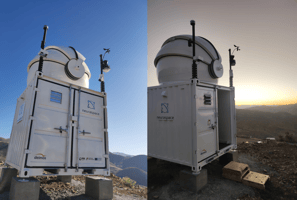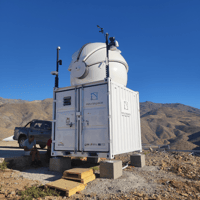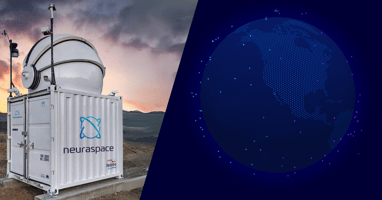We have installed and activated our second optical telescope, located in Chile, to expand satellite...
Neuraspace inaugurates its first fully operational optical telescope
.png?width=804&height=420&name=Blog_LinkedIn_Neura%20(10).png)
Portuguese Air Force relies on Neuraspace to ensure Space Safety
Lisbon, Portugal, 10 September 2024 – Neuraspace, a European-born global leader in space traffic management (STM) has inaugurated its first optical telescope in Portugal to enhance airspace safety and security as well as space sustainability. The data stemming from the telescope will be a valuable addition to Neuraspace’s existing services.
The optical telescope is installed at Air Base No. 11 in Beja as part of a nascent collaboration with the Portuguese Air Force.
The partnership between the Portuguese Air Force and Neuraspace focuses on strengthening Portugal’s capabilities in Space Situational Awareness (SSA) and Space Surveillance and Tracking (SST) and its specialisation in supporting the advancement of space security, an area that the country has long identified as being of strategic importance for its economy, civil protection and the security of critical infrastructures in space and on the ground.
The new telescope adds value to Neuraspace's Space Traffic Management Platform, an exclusive product for satellite operators, supported by artificial intelligence and machine learning, designed to carry out safe space operations and avoid collisions with space debris and other satellites. Two years after its launch, Neuraspace is already monitoring more than 300 satellites.
Using Neuraspace’s telescope together with the company’s AI (artificial intelligence) capabilities, the partnership aims to optimise space data analysis. It will transform complex information into valuable insights for defence purposes for civil protection.
The installation of the optical telescope is under the AI Fights Space Debris project funded by the Recovery and Resilience Plan (PRR). The telescope is one of the most advanced in Europe that will allow objects to be tracked with high fidelity. The data collected can be correlated with the data that Neuraspace gathers from different sources with multiple partners, thus reinforcing the information for operators who use the services of Neuraspace.
The Chief of Staff of the Air Force, General Cartaxo Alves, said that "the Air Force is changing, according to the “Air Force 5.3” flight plan presented in May this year. This change is underpinned by the institution's training in two new areas that multiply the operational product, the ‘5th Generation’ and the ‘5th Operational Domain - Space’, supported by continuous improvement measures that contribute to strengthening the Air Force's knowledge, competences and capabilities. This partnership with Neuraspace is part of the Air Force's space capability strategy, which will support space situational awareness and thus contribute to Space INTEL, which will leverage information superiority and, inherently, operational value."
Chiara Manfletti, CEO of Neuraspace said: “The launch of our new optical telescope is a significant advancement for Neuraspace, our customers, partners and stakeholders. This event marks an important milestone in our journey to grow as a global leader in the field of space safety and sustainability. Remarkably, within just hours of its deployment, the telescope has already proven instrumental in supporting several clients through the critical Launch and Early Orbit Phase (LEOP), where operators rely heavily on pinpoint accuracy for asset location.”
– ENDS –
Technical notes to editors
The Neuraspace optical telescope is capable of measuring visual or apparent magnitudes1 below 14 (down to 10 cm) objects in LEO and 16 (down to 2 m) objects in MEO and GEO.
The telescope also surpassed standard criteria due to its high angular accuracy, achieving less than 1.5 arcsec RMS (7 m at 1,000 km altitude), which enables the tracking of slower and brighter targets
Due to its ability to exceed one frame per second for LEO residents and crossing targets, it is able to scan and capture data at high-frequency (fast astrometric and photometric acquisition). Moreover, it supports multi-orbit horizon-to-horizon tracking with high agility to quickly switch between targets, producing tracks from a few seconds to tens of minutes long.
1 Apparent Magnitude is the magnitude of an object as it appears in the sky on Earth, for comparison, a full Moon has an apparent magnitude of -13 (-12.6), the International Space Station has an apparent magnitude of -6.
For more information, please contact media@neuraspace.com
###
About Neuraspace
Established in 2020, Neuraspace is a European-born company that provides solutions and services to more than 300 commercial satellites with established operators in the market to make space safe, secure, and sustainable. Neuraspace offers real-time automated space traffic management, routine space mission support software and resilient mission design, focusing on sustainability. They also leverage new-age technologies, including artificial intelligence and machine learning, to process data, automate processes, and offer valuable insights. The company’s SaaS platform facilitates coordination among satellite operators, while their Data-as-a-Service product offers comprehensive space situational awareness.
Neuraspace has raised 2.5 million euros from Armilar Venture Partners and a further 25 million euros for sensor infrastructure and its growth strategy with the support of the Recovery and Resilience Plan and NextGenerationEU Funds. To know more, visit www.neuraspace.com or check out our LinkedIn.
About the AI Fights Space Debris project
The AI Fights Space Debris project, C626449889-00463050, is part of the Mobilising Agenda/Alliances for Reindustrialisation funded by the PRR - Recovery and Resilience Plan with a budget of 25M€.
The project aims to support the growth of Neuraspace and its Space Traffic Management Platform, an exclusive product for satellite operators, supported by Artificial Intelligence and Machine Learning, designed to carry out safe space operations and avoid collisions with space debris and other satellites.
---
Image credits: © Neuraspace . All rights reserved.



